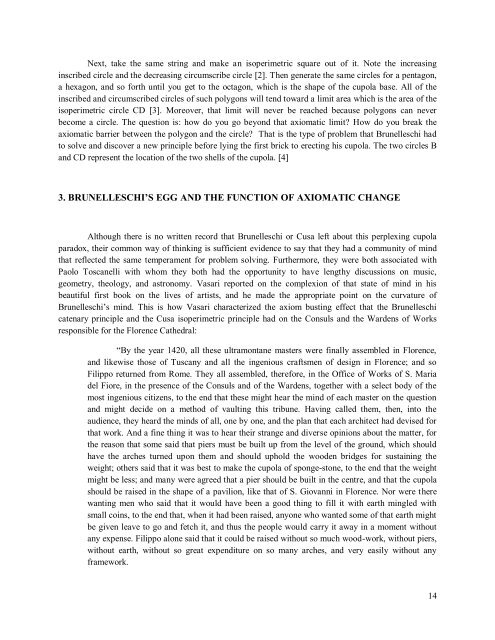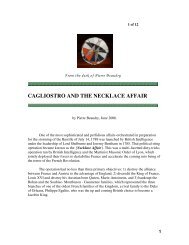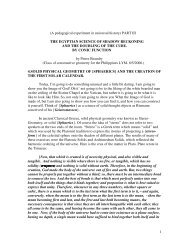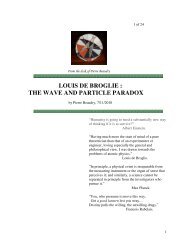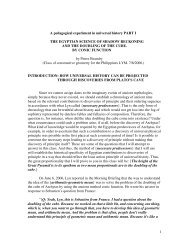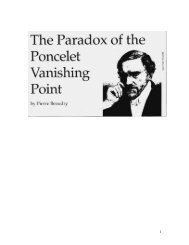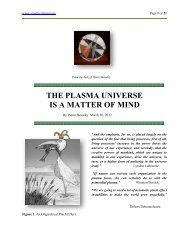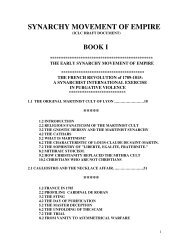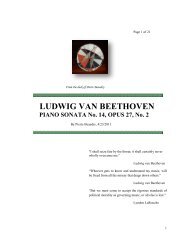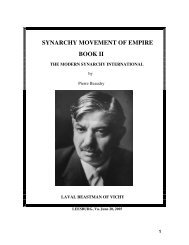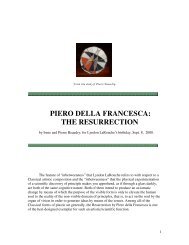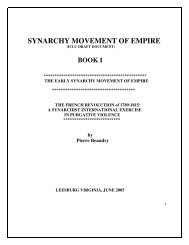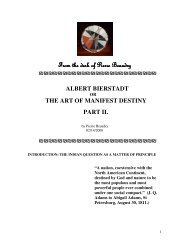filippo brunelleschi's mind and the catenary principle - Pierre ...
filippo brunelleschi's mind and the catenary principle - Pierre ...
filippo brunelleschi's mind and the catenary principle - Pierre ...
You also want an ePaper? Increase the reach of your titles
YUMPU automatically turns print PDFs into web optimized ePapers that Google loves.
Next, take <strong>the</strong> same string <strong>and</strong> make an isoperimetric square out of it. Note <strong>the</strong> increasinginscribed circle <strong>and</strong> <strong>the</strong> decreasing circumscribe circle [2]. Then generate <strong>the</strong> same circles for a pentagon,a hexagon, <strong>and</strong> so forth until you get to <strong>the</strong> octagon, which is <strong>the</strong> shape of <strong>the</strong> cupola base. All of <strong>the</strong>inscribed <strong>and</strong> circumscribed circles of such polygons will tend toward a limit area which is <strong>the</strong> area of <strong>the</strong>isoperimetric circle CD [3]. Moreover, that limit will never be reached because polygons can neverbecome a circle. The question is: how do you go beyond that axiomatic limit? How do you break <strong>the</strong>axiomatic barrier between <strong>the</strong> polygon <strong>and</strong> <strong>the</strong> circle? That is <strong>the</strong> type of problem that Brunelleschi hadto solve <strong>and</strong> discover a new <strong>principle</strong> before lying <strong>the</strong> first brick to erecting his cupola. The two circles B<strong>and</strong> CD represent <strong>the</strong> location of <strong>the</strong> two shells of <strong>the</strong> cupola. [4]3. BRUNELLESCHI’S EGG AND THE FUNCTION OF AXIOMATIC CHANGEAlthough <strong>the</strong>re is no written record that Brunelleschi or Cusa left about this perplexing cupolaparadox, <strong>the</strong>ir common way of thinking is sufficient evidence to say that <strong>the</strong>y had a community of <strong>mind</strong>that reflected <strong>the</strong> same temperament for problem solving. Fur<strong>the</strong>rmore, <strong>the</strong>y were both associated withPaolo Toscanelli with whom <strong>the</strong>y both had <strong>the</strong> opportunity to have lengthy discussions on music,geometry, <strong>the</strong>ology, <strong>and</strong> astronomy. Vasari reported on <strong>the</strong> complexion of that state of <strong>mind</strong> in hisbeautiful first book on <strong>the</strong> lives of artists, <strong>and</strong> he made <strong>the</strong> appropriate point on <strong>the</strong> curvature ofBrunelleschi’s <strong>mind</strong>. This is how Vasari characterized <strong>the</strong> axiom busting effect that <strong>the</strong> Brunelleschi<strong>catenary</strong> <strong>principle</strong> <strong>and</strong> <strong>the</strong> Cusa isoperimetric <strong>principle</strong> had on <strong>the</strong> Consuls <strong>and</strong> <strong>the</strong> Wardens of Worksresponsible for <strong>the</strong> Florence Ca<strong>the</strong>dral:“By <strong>the</strong> year 1420, all <strong>the</strong>se ultramontane masters were finally assembled in Florence,<strong>and</strong> likewise those of Tuscany <strong>and</strong> all <strong>the</strong> ingenious craftsmen of design in Florence; <strong>and</strong> soFilippo returned from Rome. They all assembled, <strong>the</strong>refore, in <strong>the</strong> Office of Works of S. Mariadel Fiore, in <strong>the</strong> presence of <strong>the</strong> Consuls <strong>and</strong> of <strong>the</strong> Wardens, toge<strong>the</strong>r with a select body of <strong>the</strong>most ingenious citizens, to <strong>the</strong> end that <strong>the</strong>se might hear <strong>the</strong> <strong>mind</strong> of each master on <strong>the</strong> question<strong>and</strong> might decide on a method of vaulting this tribune. Having called <strong>the</strong>m, <strong>the</strong>n, into <strong>the</strong>audience, <strong>the</strong>y heard <strong>the</strong> <strong>mind</strong>s of all, one by one, <strong>and</strong> <strong>the</strong> plan that each architect had devised forthat work. And a fine thing it was to hear <strong>the</strong>ir strange <strong>and</strong> diverse opinions about <strong>the</strong> matter, for<strong>the</strong> reason that some said that piers must be built up from <strong>the</strong> level of <strong>the</strong> ground, which shouldhave <strong>the</strong> arches turned upon <strong>the</strong>m <strong>and</strong> should uphold <strong>the</strong> wooden bridges for sustaining <strong>the</strong>weight; o<strong>the</strong>rs said that it was best to make <strong>the</strong> cupola of sponge-stone, to <strong>the</strong> end that <strong>the</strong> weightmight be less; <strong>and</strong> many were agreed that a pier should be built in <strong>the</strong> centre, <strong>and</strong> that <strong>the</strong> cupolashould be raised in <strong>the</strong> shape of a pavilion, like that of S. Giovanni in Florence. Nor were <strong>the</strong>rewanting men who said that it would have been a good thing to fill it with earth mingled withsmall coins, to <strong>the</strong> end that, when it had been raised, anyone who wanted some of that earth mightbe given leave to go <strong>and</strong> fetch it, <strong>and</strong> thus <strong>the</strong> people would carry it away in a moment withoutany expense. Filippo alone said that it could be raised without so much wood-work, without piers,without earth, without so great expenditure on so many arches, <strong>and</strong> very easily without anyframework.14


